剑桥雅思真题解析9-阅读TEST3
- 格式:docx
- 大小:911.57 KB
- 文档页数:16
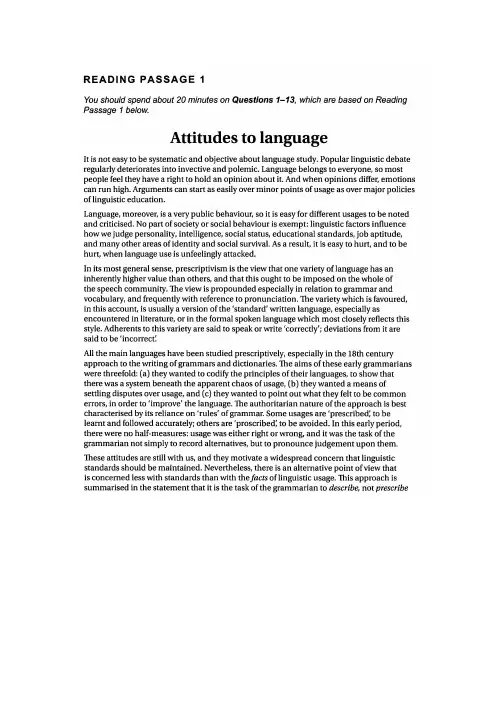
剑桥雅思阅读真题答案:Question1—8:Y、N、Y、NG、Y、Y、N、YQuestion9—12:H、F、A、CPassage1整体分析体裁说明文题材语言学主题介绍两个语言学派的观点和态度段落概括第一段背景介绍:语言的普及性导致人们容易对其持有不同的看法第二段语言在社会各方面的影响第三段语言学派“规范主义”的观点第四段规范主义依赖于严格的语法规则及其目的第五段另一个语言学派“描写主义”的观点和态度第六段两个学派的现状及他们对彼此的误解雅思阅读重点词汇第一段objective adj.客观的debate n.争论,辩论linguistic adj.语言的,语言学的deteriorate v.衰退;恶化,变坏第二段criticise v.批评,批判social status社会地位exempt adj.被免除的,被豁免的identity n.身份;同一性第三段prescriptivism n.规范主义literature n.文学deviation n.背离be imposed on被强加于……之上adherent n.追随者第四段principle n.原则chaos n.混乱reliance n.依赖avoid v.避免beneath prep.在……之下dispute n.争论accurately adv.准确地,精确地alternative n.供代替的选择第五段motivate v.激发variation n.变化,改变第六段opposition n.反对valid adj.有效的advocate n.提倡者,支持者logic n.逻辑analysis n.分析diversity n.多样性halt v.停止,阻止original adj.最初的;独创的legislation n.立法;法律extreme adj.极端的考题精解Questions 1-8题型:判断题YES/NO/NOT GIVEN解析:判断题一般都是有顺序的,确定了第一道题的原文定位后,可以向后查找其他题目的答案。
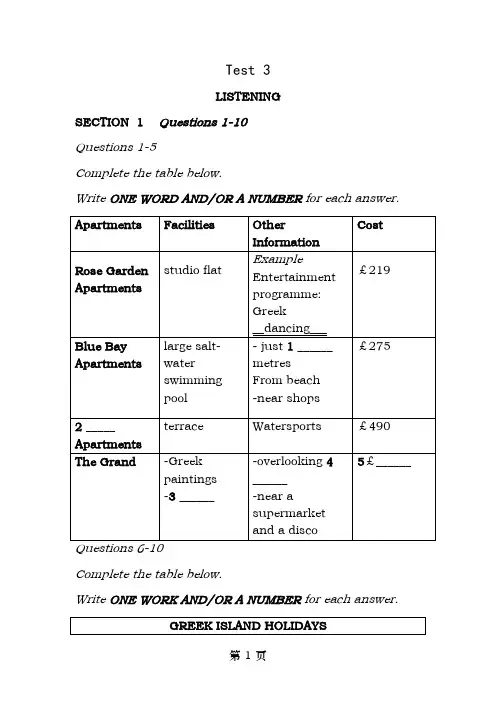
Test 3LISTENINGSECTION 1 Questions 1-10Questions 1-5Complete the table below.Write ONE WORD AND/OR A NUMBER for each answer.Complete the table below.Write ONE WORK AND/OR A NUMBER for each answer.Questions 11-13Choose the correct letter, A, B or C.Winridge Forest Railway Park11Simon’s idea for a theme park came fromA his childhood hobby.B his interest in landscape design.C his visit to another park.12 When they started, the family decided to open the park only whenA the weather was expected to be good.B the children weren’t at school.C there were fewer farming commitments.13 Since opening, the park has hadA 50,000 visitors.B 1,000,000 visitors.C 1,500,000 visitors.Questions 14-18What is currently the main area of work of each of the following people?Choose FIVE answers from the box and write the correct letter, A-H, next to questions 14-18.14 Simon (the speaker) _______15 Liz _______16 Sarah _______17 Duncan _______18 Judith _______Questions 19 and 20Complete the table below.Write ONE WORK AND/OR NUMBERS for each answer.Complete the notes below.Write NO MORE THAN TWO WORDS AND/OR A NUMBER for each answer.Study Skills Tutorial-Caroline Benning Dissertation topic: the 21______Strengths: ●22______● computer modeling Weaknesses: ● lack of background information● poor 23 ______ skills● Read all notes 29 ______Next tutorial date: 30 ______ JanuarySECTION 4 Questions 31-40Questions 31 and 32Choose the correct letter, A, B or C.31 The owners of the underground houseA had no experience of living in a rural area.B were interested in environmental issues.C wanted a professional project manager.32 What does the speaker say about the site of the house?A The land was quite cheap.B Stone was being extracted nearby.C It was in a completely unspoilt area.Questions 33-40Complete the notes below.Write ONE WORD AND/OR A NUMBER for each answer.READING PASSAGE 1You should spend about 20 minutes on Questions 1-13, which are based on Reading Passage 1 below.Attitudes to languageIt is not easy to be systematic and objective about language study. Popular linguistic debate regularly deteriorates into invective and polemic. Language belongs to everyone, so most people feel they have a right to hold an opinion about it. And when opinions differ, emotions can run high. Arguments can start as easily over minor points of usage as over major policies of linguistic education.Language, moreover, is a very public behaviour, so it is easy for different usages to be noted and criticized. No part of society or social behaviour is exempt: linguistic factorsinfluence how we judge personality, intelligence, social status, educational standards, job aptitude, and many other areas of identity and social survival. As a result, it is easy to hurt, and to be hurt, when language use is unfeelingly attacked.In its most general sense, prescriptivism is the view that one variety of language has an inherently higher value than others, and that this ought to be imposed on the whole of the speech community. The view is propounded especially in relation to grammar and vocabulary, and frequently with reference to pronunciation. The variety which is favoured, in this account, is usually a version of the ‘standard’ written language, especially as encountered in literature, or in the formal spoken language which most closely reflects this style. Adherents to this variety are said to speak orwr ite ‘correctly’; deviations from it are said to be‘incorrect’.All the main languages have been studied prescriptively, especially in the 18th century approach to the writing of grammars and dictionaries. The aims of these early grammarians were threefold: (a) they wanted to codify the principles of their languages, to show that there was a system beneath the apparent chaos of usage, (b) they wanted a means of settling disputes over usage, and (c) they wanted to point out what they felt to be common errors, in order to ‘improve’ the language. The authoritarian nature of the approach is best characterized by its reliance on‘rules’ of grammar. Some usages are ‘prescribed’, to be learnt and followed accurately; others are ‘proscribed’, to be avoided. In this early period, there were no half-measures: usage was either right or wrong, and it was thetask of the grammarian not simply to record alternatives, but to pronounce judgement upon them.These attitudes are still with us, and they motivate a widespread concern that linguistic standards should be maintained. Nevertheless, there is an alternative point of view that is concerned less with standards than with the facts of linguistic usage. This approach is summarized in the statement that it is the task of the grammarian to describe, not prescribe-to record the facts of linguistic diversity, and not to attempt the impossible tasks of evaluating language variation or halting language change. In the second half of the 18th century, we already find advocates of this view, such as Joseph Priestley, whose Rudiments of English Grammar(1761) insists that ‘the custom of speaking is the original and only just standard of any language’. Linguistic issue, it is argued, cannot be solved by logic and legislation. And this view has become the tenet of the modern linguistic approach to grammatical analysis.In our own time, the opposition between ‘descriptivists’ and ‘prescriptivists’ has often become extreme, with both sides painting unreal pictures of the other. Descriptive grammarians have been presented as people who do not care about standards, because of the way they see all forms of usage as equally valid. Prescriptive grammarians have been presented as blind adherents to a historical tradition. The opposition has even been presented in quasi-political terms — of radical liberalism vs elitist conservatism.Questions 1-8Do the following statements agree with the claims of the writer in Reading Passage 1?In boxes 1-8 on your answer sheet, writeYES if the statement agrees with the claims of the writerNO if the statement contradicts the claims of the writerNOT GIVEN if it is impossible to say what the writer thinks about this1 There are understandable reasons why arguments occur about language.2 People feel more strongly about language education thanabout small differences in language usage.3Our assessment of a person’s intelligence is affected by the way he or she uses language.4 Prescriptive grammar books cost a lot of money to buy in the 18th century.5 Prescriptivism still exists today.6 According to descriptivists it is pointless to try to stop language change.7 Descriptivism only appeared after the 18th century.8 Both descriptivists and prescriptivists have been misrepresented.Questions 9-12Complete the summary using the list of words, A-I, below. Write the correct letter, A-I, in boxes 9-12 on your answer sheet.The language debateAccording to 9______, there is only one correct form of language. Linguists who take this approach to language place great importance on grammatical 10 ______.Conversely, the view of 11 ______, such as Joseph Priestly, is that grammar should be based on 12 ______.Choose the correct letter, A, B, C or D.Write the correct letter in box 13 on your answer sheet.What is the writer’s purpose in Reading Passage 1?A.to argue in favour of a particular approach to writingdictionaries and grammar booksB.to present a historical account of differing views oflanguageC.to describe the differences between spoken and writtenlanguageD.to show how a certain view of language has beendiscreditedREADING PASSAGE 2You should spend about 20 minutes on Questions 14-26, which are based on Reading Passage 2 below.Tidal PowerUndersea turbines which produce electricity from the tides are set to become an important source of renewable energy for Britain. It is still too early to predict the extent of the impact they may have, but all the signs are that they will play a significant role in the futureA.Operating on the same principle as wind turbines, thepower in sea turbines comes from tidal currents whichturn blades similar to ships’ propellers, but, unlikewind, the tides are predictable and the power input isconstant. The technology raises the PROSPECT of Britain becoming self-sufficient in renewable energy anddrastically reducing its carbon dioxide emissions. If tide, wind and wave power are all developed, Britain would be able to close gas, coal and nuclear power plants andexport renewable power to other parts of Europe. Unlike wind power, which Britain originally developed and then abandoned for 20 years allowing the Dutch to make it a major industry, undersea turbines could become a bigexport earner to island nations such as Japan and New Zealand.B.Tidal sites have already been identified that will produceone sixth or more of the UK’s power-and at pricescompetitive with modern gas turbines and undercutting those of the already ailing nuclear industry. One sitealone, the Pentland Firth, between Orkney and mainland Scotland, could produce 10% of the country’s electricity with banks of turbines under the sea, and another atAlderney in the Channel Islands three times the 1,200megawatts of Britain’s largest and newe st nuclear plant, Sizewell B, in Suffolk. Other sites identified include theBristol Channel and the west coast of Scotland,particularly the channel between Campbeltown andNorthern Ireland.C.Work on designs for the new turbine blades and sites arewill ad vance at the University of Southampton’ssustainable energy research group. The first station isexpected to be installed off Lynmouth in Devon shortly to test the technology in a venture jointly funded by thedepartment of Trade and Industry and the EuropeanUnion. AbuBakr Bahaj, in charge of the Southamptonresearch, said: ‘The prospects for energy from tidalcurrents are far better than from wind because the flows of water are predictable and constant. The technology for dealing with the hostile saline environment under the sea has been developed in the North Sea oil industry andmuch is already known about turbine blade design,because of wind power and ship propellers. There are a few technical difficulties, but I believe in the next five to ten years we will be installing commercial marine turbine farms.’ Southampton has been awarded £215,000 over three years to develop the turbines and is working with Marine Current Turbines, a subsidiary of IT power, onthe Lynmouth project. EU research has now identified106 potential sites for tidal power, 80% round the coasts of Britain. The best sites are between islands or around heavily indented coasts where there are strong tidalcurrents.D. A marine turbine blade needs to be only one third of thesize of wind generator to produce three times as muchpower. The blades will be about 20 metres in diameter, so around 30 metres of water is required. Unlike windpower, there are unlikely to be environmental objections.Fish and other creatures are though unlikely to be atrisk from the relatively slow-turning blades. Each turbine will be mounted on a tower which will connect to thenational power supply grid via underwater cables. Thetowers will stick out of the water and be lit, to warnshipping, and also be designed to be lifted out of thewater for maintenance and to clean seaweed from theblades.E.Dr Bahaj has done most work on the Alderney site,where there are powerful currents. The single undersea turbine farm would produce far more power than needed for the Channel Islands and most would be fed into the French Grid and be re-imported into Britain via the cable under the Channel.F.One technical difficulty is cavitation, where low pressurebehind a turning blade causes air bubbles. These cancause vibration and damage the blades of the turbines.Dr Bahaj said: ‘We have to test a number of blade types to avoid this happening or at least make sure it does not damage the turbines or reduce performance. Anotherslight concern is submerged debris floating into theblades. So far we do not know how much of a problem it might be. We will have to make the turbines robustbecause the sea is a hostile environment, but all thesigns that we can do it are good.’Questions 14-17Reading Passage 2 has six paragraphs, A-F.Which paragraph contains the following information?Write the correct letter, A-F, in boxes 14-17 on your answer sheet.NB You may use any letter more than once.14 the location of the first test site15 a way of bringing the power produced on one site back into Britain16 a reference to a previous attempt by Britain to find analternative source of energy17 mention of the possibility of applying technology from another industryQuestions 18-22Choose FIVE letters, A-J.Write the correct letters in boxes 18-22 on your answer sheet.Which FIVE of the following claims about tidal power are made by the writer?Questions 23-26Label the diagram below.Choose NO MORE THAN TWO WORDS from the passage for each answer.Write your answers in boxes 23-26 on your answer sheet.An Undersea TurbineWhole tower can be raised for 23 ______ and the extraction of seaweed from the bladesSea life not in danger due to the fact that blades are comparatively 24 ______Air bubbles result from the 25 ______ behind blades. This is known as 26 ______READING PASSAGE 3You should spend about 20 minutes on Questions 27-40, which are based on Reading Passage 3 below.Information theory-the big ideaInformation theory lies at the heart of everything-from DVD players and the genetic code of DNA to the physics of the universe at its most fundamental. It has been central to the development of the science of communication, which enables data to be sent electronically and has therefore had a major impact on our livesA.In April 2002 an event took place which demonstratedone of the many applications of information theory. The space probe, Voyager I, Launched in 1997, had sent back spectacular images of Jupiter and Saturn and thensoared out of the Solar System on a one-way mission tothe stars. After 25 years of exposure to the freezingtemperatures of deep space, the probe was beginning to show its age. Sensors and circuits were on the brink of failing and NASA expers realized that they had to dosomething or lose contact with their probe forever. The solution was to get a message to Voyager I to instruct it to use spares to change the failing parts. With the probe12 billion kilometers from Earth, this was not an easytask. By means of a radio dish belonging to NASA’sDeep Space Network, the message was sent out into the depths of space. Even travelling at the speed of light, it took over 11 hours to reach its target, far beyond theorbit of Pluto. Yet, incredibly, the little probe managed to hear the faint call from its home planet, and successfully made the switchover.B.It was the longest-distance repair job in history, and atriumph for the NASA engineers. But it also highlighted the astonishing power of the techniqu4es developed by American communications engineer Claude Shannon,who had died just a year earlier. Born in 1916 inPetoskey, Michigan, Shannon showed an early talent for maths and for building gadgets, and madebreakthroughs in the foundations of computertechnology when still a student. While at BellLaboratories, Shannon developed information theory, but shunned the resulting acclaim. In the 1940s, he single-handedly created an entire science of communicationwhich has since inveigled its way into a host ofapplications, from DVDs to satellite communications to bar codes-any area, in short, where data has to beconveyed rapidly yet accurately.C.This all seems light years away from the down-to-earthuses Shannon originally had for his work, which began when he was a 22-year-old graduate engineering student at the prestigious Massachusetts Institute of Technology in 1939. He set out with an apparently simple aim: to pin down the precise meaning of the concept of‘information’. The most basic form of information,Shannon argued, is whether something is true of false —which can be captured in the binary unit, or ‘bit’, of the form 1 or 0. Having identified this fundamental unit, Shannon set about defining otherwise vague ideas about information and how to transmit it from place to place.In the process he discovered something surprising: it is always possible to guarantee information will get through random interference —‘noise’— intact.D.Noise usually means unwanted sounds which interferewith genuine information. Information theory generalizes this idea via theorems that capture the effects of noisewith mathematical precision. In particular, Shannonshowed that noise sets a limit on the rate at whichinformation can pass along communication channelswhile remaining error-free. This rate depends on therelative strengths of the signal and noise travelling down the communication channel, and on its capacity (its‘bandwidth’). The resulting limit, gi ven in units of bits per second, is the absolute maximum rate of error-free communication given singal strength and noise leve. The trick, Shannon showed, is to find ways of packaging up —‘coding’— information to cope with the ravages of noise, while staying within the information-carryingcapacity —‘bandwidth’— of the communicationsystem being used.E.Over the years scientists have devised many such codingmethods, and they have proved crucial in manytechnological feat. The Voyager spacecraft transmitteddata using codes which added one extra bit for everysingle bit of information; the result was an error rate of just one bit in 10,000-and stunningly clear pictures ofthe planets. Other codes have become part of everydaylife-such as the Universal Product Code, or bar code,which uses a simple error-detecting system that ensures supermarket check-out lasers can read the price even on, say, a crumpled bag of crisps. As recently as 1993,engineers made a major breakthrough by discovering so-called turbo codes-which come very close to Shannon’s ultimate limit for the maximum rate that data can betransmitted reliable, and now play a key role in themobile videophone revolution.F.Shannon also laid the foundations of more efficient waysof storing information, by stripping out superfluous(‘redundant’) bits from data which contributed littlereal information. As mobile phone text messages like ‘I CN C U’ show, it is often possible to leave out a lot ofdata without losing much meaning. As with errorcorrecting, h owever, there’s a limit beyond whichmessages become too ambiguous. Shannon showed how to calculate this limit, opening the way to the design ofcompression methods that cram maximum information into the minimum space.Questions 27-32Reading Passage 3 has six paragraphs, A-F.Which paragraph contains the following information?Write the correct letter, A-F, in boxes 27-32 on your answer sheet.27 an explanation of the factors affecting the transmission of information28 an example of how unnecessary information can be omitted29 a reference to Shannon’s attitude to fame30 details of a machine capable of interpreting incomplete information31 a detailed account of an incident involving information theory32 a reference to what Shannon initially intended to achieve in his researchQuestions 33-37Complete the notes below.Choose NO MORE THAN TWO WORDS form the passage for each answer.Write your answers in boxes 33-37 on your answer sheet.The Voyager 1 Space Probe●The probe transmitted pictures of both 33______ and______, then left the 34 ______.●The freezing temperatures were found to have a negativeeffect on parts of the space probe.●Scientists feared that both the 35 ______ and ______ wereabout to stop working.●The only hope was to tell the probe to replace them with36 ______ — but distance made communication with theprobe difficult.● A 37 ______ was used to transmit the message at thespeed of light.●The message was picked up by the probe and theswitchover took place.Questions 38-40Do the following statements agree with the information given in Reading PassGE 3?In boxes 38-40 on your answer sheet, writeTRUE if the statement agrees with the informationFALSE if the statement contradicts the informationNOT GIVEN if there is no information on this38 The concept of describing something as true or falsewas the starting point for Shannon in his attempts tosend message over distances.39 The amount of information that can be sent in a giventime period is determined with reference to the signalstrength and noise level.40 Products have now been developed which can conveymore information than Shannon had anticipated aspossible.WRITINGWRITING TASK1You should spend about 20 minutes on this task.WRITING TASK2You should spend about 40 minutes on this task.Write about the following topic:examples from your own knowledge or experience. Write at least 250 words.SPEAKINGPART 1The examiner asks the candidate about him/herself, his/her home, work or studies and other familiar topics. EXAMPLETelephoning●How often do you make telephone calls? [Why/Why not?]●Who do you spend most time talking to on thetelephone?[Why?]●When do you think you’ll next make a telephonecall?[Why?]●Do you sometimes prefer to send a text message insteadof telephoning? [Why/Why not?]PART 2the topic for one to two minutes.You have one minute to think about what you are going to say.You can make some notes to help you if you wish.PART 3Discussion topics:Reasons for daily travelExample questions:Why do people need to travel every day?What problems can people have when they are on their daily journey, for example to work or school? Why is this?Some people say that daily journeys like these will not be so common in the future. Do you agree or disagree? Why? Benefits of international travelExample questions:What do you think people can learn from travelling to other countries? Why?Can travel make a positive difference to the economy of a country? How?Do you think a society can benefit if its members have experience of travelling to other countries? In what ways?。
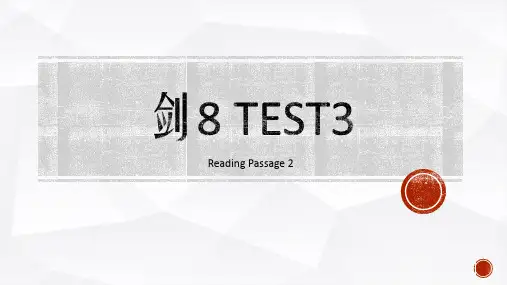
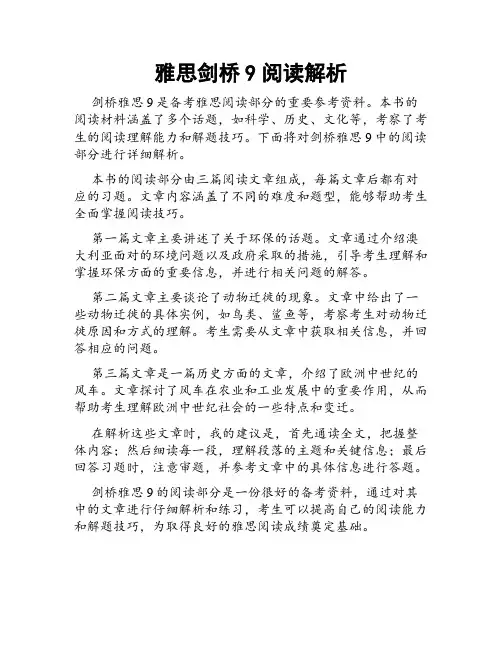
雅思剑桥9阅读解析
剑桥雅思9是备考雅思阅读部分的重要参考资料。
本书的阅读材料涵盖了多个话题,如科学、历史、文化等,考察了考生的阅读理解能力和解题技巧。
下面将对剑桥雅思9中的阅读部分进行详细解析。
本书的阅读部分由三篇阅读文章组成,每篇文章后都有对应的习题。
文章内容涵盖了不同的难度和题型,能够帮助考生全面掌握阅读技巧。
第一篇文章主要讲述了关于环保的话题。
文章通过介绍澳大利亚面对的环境问题以及政府采取的措施,引导考生理解和掌握环保方面的重要信息,并进行相关问题的解答。
第二篇文章主要谈论了动物迁徙的现象。
文章中给出了一些动物迁徙的具体实例,如鸟类、鲨鱼等,考察考生对动物迁徙原因和方式的理解。
考生需要从文章中获取相关信息,并回答相应的问题。
第三篇文章是一篇历史方面的文章,介绍了欧洲中世纪的风车。
文章探讨了风车在农业和工业发展中的重要作用,从而帮助考生理解欧洲中世纪社会的一些特点和变迁。
在解析这些文章时,我的建议是,首先通读全文,把握整体内容;然后细读每一段,理解段落的主题和关键信息;最后回答习题时,注意审题,并参考文章中的具体信息进行答题。
剑桥雅思9的阅读部分是一份很好的备考资料,通过对其中的文章进行仔细解析和练习,考生可以提高自己的阅读能力和解题技巧,为取得良好的雅思阅读成绩奠定基础。
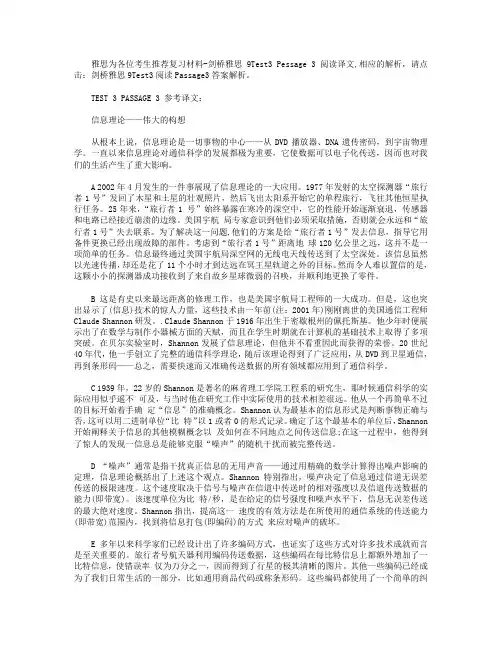
雅思为各位考生推荐复习材料-剑桥雅思9Test3 Pessage 3 阅读译文,相应的解析,请点击:剑桥雅思9Test3阅读Passage3答案解析。
TEST 3 PASSAGE 3 参考译文:信息理论——伟大的构想从根本上说,信息理论是一切事物的中心——从DVD播放器、DNA遗传密码,到宇宙物理学。
一直以来信息理论对通信科学的发展都极为重要,它使数据可以电子化传送,因而也对我们的生活产生了重大影响。
A 2002年4月发生的一件事展现了信息理论的一大应用。
1977年发射的太空探测器“旅行者1号”发回了木星和土星的壮观照片,然后飞出太阳系开始它的单程旅行,飞往其他恒星执行任务。
25年来,“旅行者1 号”始终暴露在寒冷的深空中,它的性能开始逐渐衰退,传感器和电路已经接近崩溃的边缘。
美国宇航局专家意识到他们必须采取措施,否则就会永远和“旅行者1号”失去联系。
为了解决这一问题,他们的方案是给“旅行者1号”发去信息,指导它用备件更换已经出现故障的部件。
考虑到“旅行者1号”距离地球120亿公里之远,这并不是一项简单的任务。
信息最终通过美国宇航局深空网的无线电天线传送到了太空深处。
该信息虽然以光速传播,却还是花了11个小时才到达远在冥王星轨道之外的目标。
然而令人难以置信的是,这颗小小的探测器成功接收到了来自故乡星球微弱的召唤,并顺利地更换了零件。
B这是有史以来最远距离的修理工作,也是美国宇航局工程师的一大成功。
但是,这也突出显示了(信息)技术的惊人力量,这些技术由一年前(注:2001年)刚刚离世的美国通信工程师Claude Shannon研发。
.Claude Shannon于1916年出生于密歇根州的佩托斯基。
他少年时便展示出了在数学与制作小器械方面的天赋,而且在学生时期就在计算机的基础技术上取得了多项突破。
在贝尔实验室时,Shannon发展了信息理论,但他并不看重因此而获得的荣誉。
20世纪40年代,他一手创立了完整的通信科学理论,随后该理论得到了广泛应用,从DVD到卫星通信,再到条形码——总之,需要快速而又准确传送数据的所有领域都应用到了通信科学。
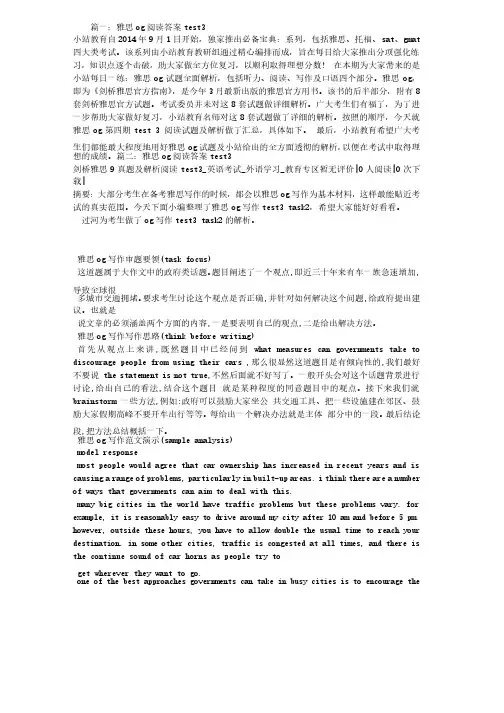
篇一:雅思og 阅读答案test3小站教育自2014年9月1日开始,独家推出必备宝典:系列,包括雅思、托福、日开始,独家推出必备宝典:系列,包括雅思、托福、sat sat sat、、gmat 四大类考试。
该系列由小站教育教研组通过精心编排而成,旨在每日给大家推出分项强化练习,习,知识点逐个击破,知识点逐个击破,知识点逐个击破,助大家做全方位复习,助大家做全方位复习,助大家做全方位复习,以顺利取得理想分数!以顺利取得理想分数!在本期为大家带来的是小站每日一练:雅思og 试题全面解析,包括听力、阅读、写作及口语四个部分。
雅思og og,,即为《剑桥雅思官方指南》,是今年3月最新出版的雅思官方用书。
该书的后半部分,附有8套剑桥雅思官方试题。
考试委员并未对这8套试题做详细解析。
广大考生们有福了,为了进一步帮助大家做好复习,小站教育名师对这8套试题做了详细的解析。
按照的顺序,今天就雅思og 第四期test 3 test 3 阅读试题及解析做了汇总,具体如下。
阅读试题及解析做了汇总,具体如下。
最后,小站教育希望广大考生们都能最大程度地用好雅思og 试题及小站给出的全方面透彻的解析,以便在考试中取得理想的成绩。
篇二:雅思og 阅读答案test3剑桥雅思9真题及解析阅读test3_test3_英语考试英语考试英语考试__外语学习外语学习__教育专区暂无评价教育专区暂无评价|0|0人阅读人阅读|0|0次下载|摘要:大部分考生在备考雅思写作的时候,大部分考生在备考雅思写作的时候,都会以雅思都会以雅思og 写作为基本材料,这样最能贴近考试的真实范围。
今天下面小编整理了雅思og 写作test3 task2test3 task2,希望大家能好好看看。
,希望大家能好好看看。
过河为考生做了og 写作test3 task2的解析。
雅思og 写作审题要领写作审题要领(task focus) (task focus)这道题属于大作文中的政府类话题。
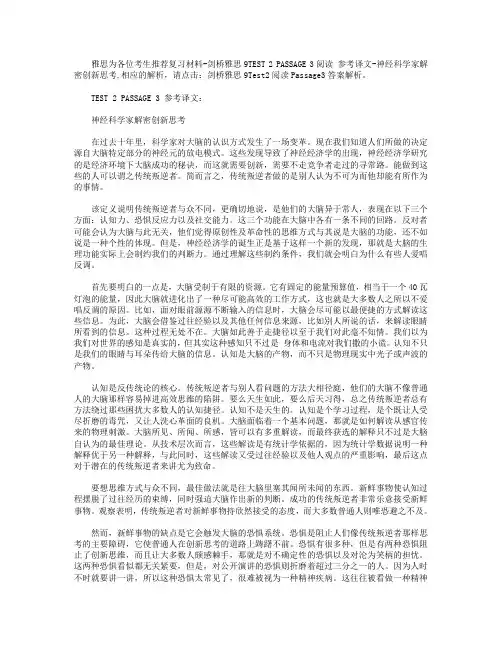
雅思为各位考生推荐复习材料-剑桥雅思9TEST 2 PASSAGE 3阅读参考译文-神经科学家解密创新思考,相应的解析,请点击:剑桥雅思9Test2阅读Passage3答案解析。
TEST 2 PASSAGE 3 参考译文:神经科学家解密创新思考在过去十年里,科学家对大脑的认识方式发生了一场变革。
现在我们知道人们所做的决定源自大脑特定部分的神经元的放电模式。
这些发现导致了神经经济学的出现,神经经济学研究的是经济环境下大脑成功的秘诀,而这就需要创新,需要不走竞争者走过的寻常路。
能做到这些的人可以谓之传统叛逆者。
简而言之,传统叛逆者做的是别人认为不可为而他却能有所作为的事情。
该定义说明传统叛逆者与众不同,更确切地说,是他们的大脑异于常人,表现在以下三个方面:认知力、恐惧反应力以及社交能力。
这三个功能在大脑中各有一条不同的回路。
反对者可能会认为大脑与此无关,他们觉得原创性及革命性的思维方式与其说是大脑的功能,还不如说是一种个性的体现。
但是,神经经济学的诞生正是基于这样一个新的发现,那就是大脑的生理功能实际上会制约我们的判断力。
通过理解这些制约条件,我们就会明白为什么有些人爱唱反调。
首先要明白的一点是,大脑受制于有限的资源。
它有固定的能量预算值,相当于一个40瓦灯泡的能量,因此大脑就进化出了一种尽可能高效的工作方式,这也就是大多数人之所以不爱唱反调的原因。
比如,面对眼前源源不断输入的信息时,大脑会尽可能以最便捷的方式解读这些信息。
为此,大脑会借鉴过往经验以及其他任何信息来源,比如別人所说的话,来解读眼睛所看到的信息。
这种过程无处不在。
大脑如此善于走捷径以至于我们对此毫不知情。
我们以为我们对世界的感知是真实的,但其实这种感知只不过是身体和电流对我们撒的小谎。
认知不只是我们的眼睛与耳朵传给大脑的信息。
认知是大脑的产物,而不只是物理现实中光子或声波的产物。
认知是反传统论的核心。
传统叛逆者与别人看问题的方法大相径庭,他们的大脑不像普通人的大脑那样容易掉进高效思维的陷阱。
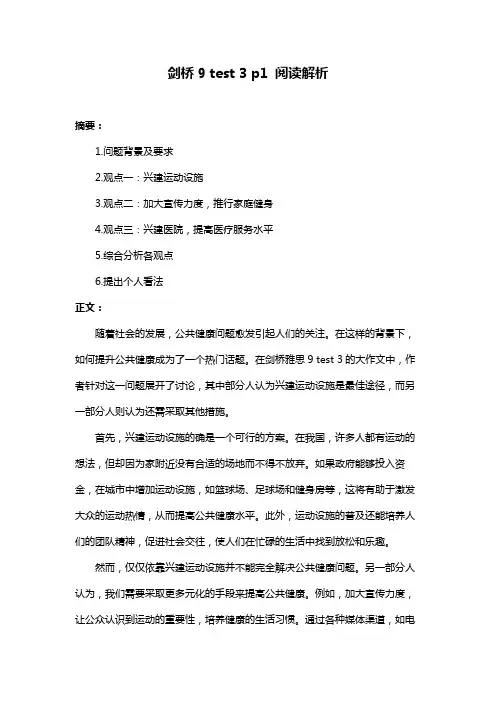
剑桥9 test 3 p1 阅读解析摘要:1.问题背景及要求2.观点一:兴建运动设施3.观点二:加大宣传力度,推行家庭健身4.观点三:兴建医院,提高医疗服务水平5.综合分析各观点6.提出个人看法正文:随着社会的发展,公共健康问题愈发引起人们的关注。
在这样的背景下,如何提升公共健康成为了一个热门话题。
在剑桥雅思9 test 3的大作文中,作者针对这一问题展开了讨论,其中部分人认为兴建运动设施是最佳途径,而另一部分人则认为还需采取其他措施。
首先,兴建运动设施的确是一个可行的方案。
在我国,许多人都有运动的想法,但却因为家附近没有合适的场地而不得不放弃。
如果政府能够投入资金,在城市中增加运动设施,如篮球场、足球场和健身房等,这将有助于激发大众的运动热情,从而提高公共健康水平。
此外,运动设施的普及还能培养人们的团队精神,促进社会交往,使人们在忙碌的生活中找到放松和乐趣。
然而,仅仅依靠兴建运动设施并不能完全解决公共健康问题。
另一部分人认为,我们需要采取更多元化的手段来提高公共健康。
例如,加大宣传力度,让公众认识到运动的重要性,培养健康的生活习惯。
通过各种媒体渠道,如电视、报纸、网络等,宣传健康知识,促使人们将运动纳入日常生活。
此外,推行家庭健身也是一种实用的方法。
随着科技的发展,家庭健身器材越来越多样化,如跑步机、健身球等。
人们可以在家里进行锻炼,节省时间成本,提高运动效率。
再者,兴建医院和完善医疗服务水平也是提升公共健康的重要途径。
当人们生病时,能够得到及时有效的治疗,有助于恢复健康。
同时,通过定期体检和关注身体状况,可以预防潜在的健康问题。
因此,在增加运动设施的基础上,我们还应关注医疗服务的质量,为公众提供更好的就医环境。
综合以上观点,我们可以发现,提升公共健康需要多管齐下。
兴建运动设施、加大宣传力度、推行家庭健身和提高医疗服务水平等措施均有助于提高公共健康水平。
然而,在实际操作中,我们还需根据各地区的情况和人群需求,制定有针对性的政策。
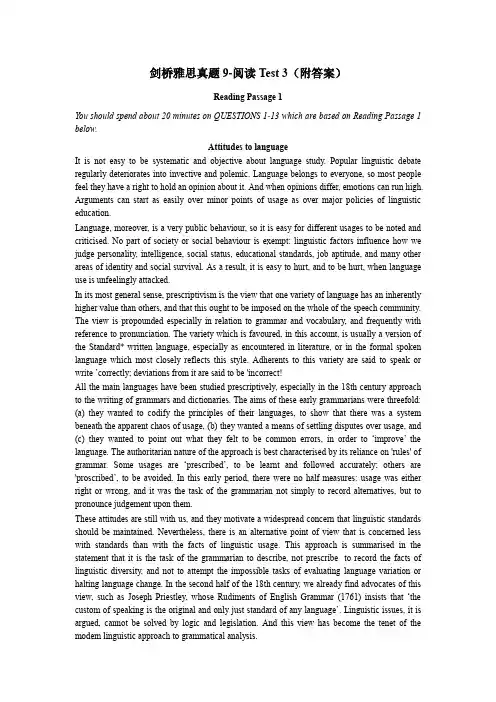
剑桥雅思真题9-阅读Test 3(附答案)Reading Passage 1You should spend about 20 minutes on QUESTIONS 1-13 which are based on Reading Passage 1 below.Attitudes to languageIt is not easy to be systematic and objective about language study. Popular linguistic debate regularly deteriorates into invective and polemic. Language belongs to everyone, so most people feel they have a right to hold an opinion about it. And when opinions differ, emotions can run high. Arguments can start as easily over minor points of usage as over major policies of linguistic education.Language, moreover, is a very public behaviour, so it is easy for different usages to be noted and criticised. No part of society or social behaviour is exempt: linguistic factors influence how we judge personality, intelligence, social status, educational standards, job aptitude, and many other areas of identity and social survival. As a result, it is easy to hurt, and to be hurt, when language use is unfeelingly attacked.In its most general sense, prescriptivism is the view that one variety of language has an inherently higher value than others, and that this ought to be imposed on the whole of the speech community. The view is propounded especially in relation to grammar and vocabulary, and frequently with reference to pronunciation. The variety which is favoured, in this account, is usually a version of the Standard* written language, especially as encountered in literature, or in the formal spoken language which most closely reflects this style. Adherents to this variety are said to speak or write ’correctly; deviations from it are said to be 'incorrect!All the main languages have been studied prescriptively, especially in the 18th century approach to the writing of grammars and dictionaries. The aims of these early grammarians were threefold: (a) they wanted to codify the principles of their languages, to show that there was a system beneath the apparent chaos of usage, (b) they wanted a means of settling disputes over usage, and (c) they wanted to point out what they felt to be common errors, in order to ‘improve’ the language. The authoritarian nature of the approach is best characterised by its reliance on 'rules' of grammar. Some usages are ‘prescribed’, to be learnt and followed accurately; others are 'proscribed’, to be avoided. In this early period, there were no half-measures: usage was either right or wrong, and it was the task of the grammarian not simply to record alternatives, but to pronounce judgement upon them.These attitudes are still with us, and they motivate a widespread concern that linguistic standards should be maintained. Nevertheless, there is an alternative point of view that is concerned less with standards than with the facts of linguistic usage. This approach is summarised in the statement that it is the task of the grammarian to describe, not prescribe -to record the facts of linguistic diversity, and not to attempt the impossible tasks of evaluating language variation or halting language change. In the second half of the 18th century, we already find advocates of this view, such as Joseph Priestley, whose Rudiments of English Grammar (1761) insists that ‘the custom of speaking is the original and only just standard of any language’. Linguistic issues, it is argued, cannot be solved by logic and legislation. And this view has become the tenet of the modem linguistic approach to grammatical analysis.In our own time, the opposition between 'descriptivists’ and 'prescriptivists’ has often become extreme, with both sides painting unreal pictures of the other. Descriptive grammarians have been presented as people who do not care about standards, because of the way they see all forms of usage as equally valid. Prescriptive grammarians have been presented as blind adherents to a historical tradition. The opposition has even been presented in quasi-political terms -of radical liberalism vs elitist conservatism.Question 1-8Do the following statements agree with the claims of the writer in Reading Passage 1?In boxes 1-8 on your answer sheet, writeYES if the statement agrees with the claims of the writerNO if the statement contradicts the claims of the writerNOT GIVEN if it is impossible to say what the writer thinks about this1. There are understandable reasons why arguments occur about language.2. People feel more strongly about language education than about small differences in language usage.3. Our assessment of a person's intelligence is affected by the way he or she uses language.4. Prescriptive grammar books cost a lot of money to buy in the 18th century.5. Prescriptivism still exists today.6. According to descriptivists it is pointless to try to stop language change.7. Descriptivism only appeared after the 18th century.8. Both descriptivists and prescriptivists have been misrepresented.Question 9-12Complete the summary using the list of words, A-I, below.Drag the correct letter, A-I, into boxes 9-12 on your answer sheet.According to 9………..., there is only one correct form of language. Linguists who take this approach to language place great importance on grammatical 10 ………… .Conversely, the view of 11…………., such as Joseph Priestley, is that grammar should be based on 12 ………… .Choose the correct letter, A, B, C or D.Write the correct letter in box 13 on your answer sheet.13. What is the writers purpose in Reading Passage 1?A. to argue in favour of a particular approach to writing dictionaries and grammar booksB. to present a historical account of differing views of languageC. to describe the differences between spoken and written languageD. to show how a certain view of language has been discreditedReading Passage 2You should spend about 20 minutes on QUESTIONS 14-27 which are based on Reading Passage 2 below.Tidal PowerUndersea turbines which produce electricity from the tides are set to become an important source of renewable energy for Britain. It is still too early to predict the extent of the impact they may have, but all the signs are that they will play a significant role in the futureA Operating on the same principle as wind turbines, the power in sea turbines comes from tidal currents which turn blades similar to ships' propellers, but, unlike wind, the tides are predictable and the power input is constant. The technology raises the prospect of Britain becoming self-sufficient in renewable energy and drastically reducing its carbon dioxide emissions. If tide, wind and wave power are all developed. Britain would be able to close gas, coal and nuclear power plants and export renewable power to other parts of Europe. Unlike wind power, which Britain originally developed and then abandoned for 20 years allowing the Dutch to make it a major industry, undersea turbines could become a big export earner to island nations such as Japan and New Zealand.B Tidal sites have already been identified that will produce one sixth or more of the UK's power - and at prices competitive with modem gas turbines and undercutting those of the already ailing nuclear industry. One site alone, the Pentland Firth, between Orkney and mainland Scotland, could produce 10% of the country's electricity with banks of turbines under the sea, and another at Alderney in the Channel Islands three times the 1,200 megawatts of Britain's largest and newest nuclear plant, Sizewell B, in Suffolk. Othep sites identified include the Bristol Channel and the west coast of Scotland, particularly the channel between Campbeltown and Northern Ireland.C Work on designs for the new turbine blades and sites are well advanced at the University of Southampton's sustainable energy research group. The first station is expected to be installed off Lynmouth in Devon shortly to test the technology in a venture jointly funded by the department of Trade and Industry and the European Union. AbuBakr Bahaj, in charge of the Southampton research, said: The prospects for energy from tidal currents are far better than from wind because the flows of water are predictable and constant. The technology for dealing with the hostile saline environment under the sea has been developed in the North Sea oil industry and much is already known about turbine blade design, because of wind power and ship propellers. There are a few technical difficulties, but I believe in the next five to ten years we will be installing commercial marine turbine farms. Southampton has been awarded £215,000 over three years to develop the turbines and is working with Marine Current Turbines, a subsidiary of IT power, on the Lynmouth project. EU research has now identified 106 potential sites for tidal power, 80% round the coasts of Britain. The best sites are between islands or around heavily indented coasts where there are strong tidal currents.D A marine turbine blade needs to be only one third of the size of a wind generator to produce three times as much power. The blades will be about 20 metres in diameter, so around 30 metres of water is required. Unlike wind power, there are unlikely be environmental objections. Fish and other creatures are thought unlikely to be at risk from the relatively slow-turning blades. Each turbine will be mounted on a tower which will connect to the national power supply grid viaunderwater cables. The towers will stick out of the water and be lit, to warn shipping, and also be designed to be lifted out of the water for maintenance and to clean seaweed from the blades.E Dr Bahaj has done most work on the Alderney site, where there are powerful currents. The single undersea turbine farm would produce far more power than needed for the Channel Islands and most would be fed into the French Grid and be re-imported into Britain via the cable under the Channel.F One technical difficulty is cavitation, where low pressure behind a turning blade causes air bubbles. These can cause vibration and damage the blades of the turbines. Dr Bahaj said: ‘We have to test a number of blade types to avoid this happening or at least make sure it does not damage the turbines or reduce performance. Another slight concern is submerged debris floating into the blades. So far we do not know how much of a problem it might be. We will have to make the turbines robust because the sea is a hostile environment, but all the signs that we can do it are good.'Questions 14-17Reading Passage 2 has six paragraphs, A-F.Which paragraph contains the following information?Write the correct letter, A-F, in boxes 14-17 on your answer sheet.NB You may use any letter more than once.14. the location of the first test site15. a way of bringing the power produced on one site back into Britain16. a reference to a previous attempt by Britain to find an alternative source of energy17. mention of the possibility of applying technology from another industryQuestions 18-22Choose FIVE letters, A-J.Write the correct letters in boxes 18-22 on your answer sheet.Which FIVE of the following claims about tidal power are made by the writer?Label the diagram below.Choose NO MORE THAN TWO WORDS from the passage for each answer.Write your answers in boxes 23-26 on your answer sheet.An Undersea TurbineReading Passage 3You should spend about 20 minutes on QUESTIONS 27-40 which are based on Reading Passage 3 below.Information theory-the big ideaInformation theory lies at the heart of everything —from DVD players and the genetic code of DNA to the physics of the universe at its most fundamental. It has been central to the development of the science of communication, which enables data to be sent electronically and has therefore had a major impact on our livesA In April 2002 an event took place which demonstrated one of the many applications of information theory. The space probe, V oyager I, launched in 1977, had sent back spectacular images of Jupiter and Saturn and then soared out of the Solar System on a one-way mission to the stars. After 25 years of exposure to the freezing temperatures of deep space, the probe was beginning to show its age. Sensors and circuits were on the brink of failing and NASA experts realised that they had to do something or lose contact with their probe forever. The solution was to get a message to Voyager I to instruct it to use spares to change the failing parts. With the probe 12 billion kilometres from Earth, this was not an easy task. By means of a radio dish belonging to NASA's Deep Space Network, the message was sent out into the depths of space. Even travelling at the speed of light, it took over 11 hours to reach its target, far beyond the orbit of Pluto. Yet, incredibly, the little probe managed to hear the faint call from its home planet, and successfully made the switchover.B It was the longest-distance repair job in history, and a triumph for the NASA engineers. But it also highlighted the astonishing power of the techniques developed by American communications engineer Claude Shannon, who had died just a year earlier. Born in 1916 in Petoskey, Michigan, Shannon showed an early talent for maths and for building gadgets, and made breakthroughs in the foundations of computer technology when still a student. While at BellLaboratories, Shannon developed information theory, but shunned the resulting acclaim. In the 1940s, he single-handedly created an entire science of communication which has since inveigled its way into a host of applications, from DVDs to satellite communications to bar codes - any area, in short, where data has to be conveyed rapidly yet accurately.C This all seems light years away from the down-to-earth uses Shannon originally had for his work, which began when he was a 22-year-old graduate engineering student at the prestigious Massachusetts Institute of Technology in 1939. He set out with an apparently simple aim: to pin down the precise meaning of the concept of 'information’. The most basic form of information, Shannon argued, is whether something is true or false - which can be captured in the binary unit, or 'bit', of the form 1 or 0. Having identified this fundamental unit, Shannon set about defining otherwise vague ideas about information and how to transmit it from place to place.In the process he discovered something surprising: it is always possible to guarantee information will get through random interference – ‘noise’, - intact.D Noise usually means unwanted sounds which interfere with genuine information. Information theory generalises this idea via theorems that capture the effects of noise with mathematical precision. In particular, Shannon showed that noise sets a limit on the rate at which information can pass along communication channels while remaining error-free. This rate depends on the relative strengths of the signal and noise travelling down the communication channel, and on its capacity (its ‘bandwidth’). The resulting limit, given in units of bits per second, is the absolute maximum rate of error-free communication given signal strength and noise level. The trick, Shannon showed, is to find ways of packaging up – ‘coding’, - information to cope with the ravages of noise, while staying within the information-carrying capacity -'bandwidth* -of the communication system being used.E Over the years scientists have devised many such coding methods, and they have proved crucial in many technological feats. The Voyager spacecraft transmitted data using codes which added one extra bit for every single bit of information; the result was an error rate of just one bit in 10,000 - and stunningly clear pictures of the planets. Other codes have become part of everyday life - such as the Universal Product Code, or bar code, which uses a simple error-detecting system that ensures supermarket check-out lasers can read the price even on, say, a crumpled bag of crisps. As recently as 1993, engineers made a major breakthrough by discovering so-called turbo codes -which come very close to Shannon's ultimate limit for the maximum rate that data can be transmitted reliably, and now play a key role in the mobile videophone revolution.F Shannon also laid the foundations of more efficient ways of storing information, by stripping out superfluous (‘redundant’) bits from data which contributed little real information. As mobile phone text messages like ‘I CN C U’ show, it is often possible to leave out a lot of data without losing much meaning. As with error correction, however, there’s a limit beyond which messages become too ambiguous. Shannon showed how to calculate this limit, opening the way to the design of compression methods that cram maximum information into the minimum space. Questions 27-32Reading Passage 3 has six paragraphs, A-F.Which paragraph contains the following information?Write the correct letter, A-F, in boxes 27-32 on your answer sheet.27. an explanation of the factors affecting the transmission of information28. an example of how unnecessary information can be omitted29. a reference to Shannon's attitude to fame30. details of a machine capable of interpreting incomplete information31. a detailed account of an incident involving information theory32. a reference to what Shannon initially intended to achieve in his researchQuestions 33-37Complete the notes below.Choose NO MORE THAN TWO WORDS form the passage for each answer.Write your answers in boxes 33-37 on your answer sheet.•The probe transmitted pictures of both 33______ and ______, then left the 34 ______.•The freezing temperatures were found to have a negative effect on parts of the space probe.•Scientists feared that both the 35 ______ and ______ were about to stop working.•The only hope was to tell the probe to replace them with 36 ______ —but distance made communication with the probe difficult.•A 37 ______ was used to transmit the message at the speed of light.•The message was picked up by the probe and the switchover took place.Questions 38-40Do the following statements agree with the information given in Reading Passage 3?In boxes 38-40 on your answer sheet, writeTRUE if the statement agrees with the informationFALSE if the statement contradicts the informationNOT GIVEN if there is no information on this38 The concept of describing something as true or false was the starting point for Shannon in his attempts to send messages over distances.39 The amount of information that can be sent in a given time period is determined with reference to the signal strength and noise level.40 Products have now been developed which can convey more information than Shannon had anticipated as possible.参考答案1 YES2 NO3 YES4 NOT GIVEN5 YES6 YES7 NO8 YES9 H10 F11 A12 C13B14C15E16A17C18-22 (IN ANY ORDER) ADEFJ23 maintenance24 slow (turning)25 low pressure26 cavitation27D28F29B30E31A32C33 (IN EITHER ORDER; BOTH REQUIRED FOR ONE MARK) Jupiter; Saturn34 Solar System35 (IN EITHER ORDER; BOTH REQUIRED FOR ONE MARK) sensors; circuits36 spares37 radio dish38 TRUE39 TRUE40 FALSE。
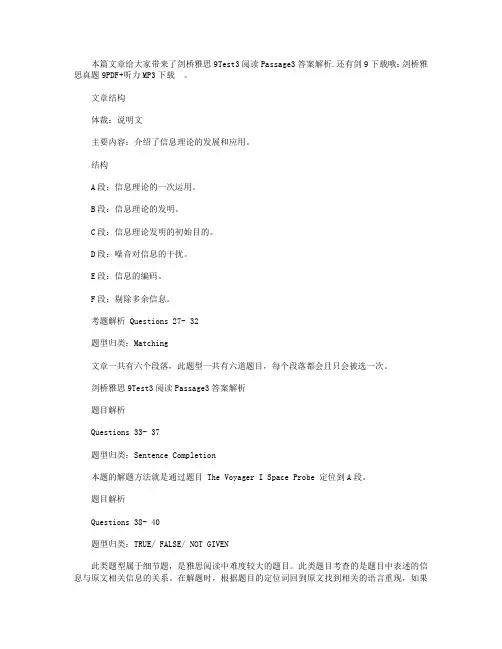
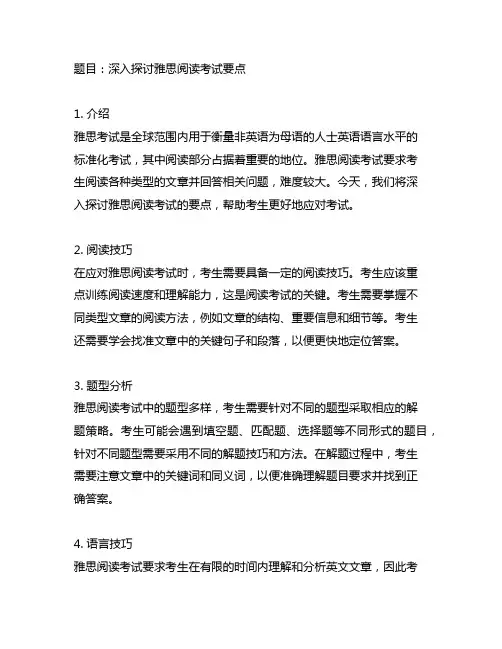
题目:深入探讨雅思阅读考试要点1. 介绍雅思考试是全球范围内用于衡量非英语为母语的人士英语语言水平的标准化考试,其中阅读部分占据着重要的地位。
雅思阅读考试要求考生阅读各种类型的文章并回答相关问题,难度较大。
今天,我们将深入探讨雅思阅读考试的要点,帮助考生更好地应对考试。
2. 阅读技巧在应对雅思阅读考试时,考生需要具备一定的阅读技巧。
考生应该重点训练阅读速度和理解能力,这是阅读考试的关键。
考生需要掌握不同类型文章的阅读方法,例如文章的结构、重要信息和细节等。
考生还需要学会找准文章中的关键句子和段落,以便更快地定位答案。
3. 题型分析雅思阅读考试中的题型多样,考生需要针对不同的题型采取相应的解题策略。
考生可能会遇到填空题、匹配题、选择题等不同形式的题目,针对不同题型需要采用不同的解题技巧和方法。
在解题过程中,考生需要注意文章中的关键词和同义词,以便准确理解题目要求并找到正确答案。
4. 语言技巧雅思阅读考试要求考生在有限的时间内理解和分析英文文章,因此考生需要具备一定的英文语言技巧。
在备考阶段,考生应该注重积累英文词汇和短语,提高语言理解和表达能力。
考生还需要掌握英文语法和句型结构,以便更好地理解文章内容和准确回答问题。
5. 总结与展望雅思阅读考试对考生的语言能力和阅读技巧提出了较高的要求,因此考生需要在备考过程中深入掌握阅读技巧、题型分析和语言技巧。
在实际考试中,考生应该注重细节,有针对性地解题,并不断提高英文阅读能力和解题水平。
希望考生能够通过努力和实践,取得理想的成绩,为未来的学习和职业发展打下良好的基础。
个人观点:在我看来,雅思阅读考试是对考生英文阅读能力和解题能力的全面考核,备考阅读考试需要不断练习和提高。
我建议考生在备考过程中注重考试要点的掌握,多做模拟试题和真题,不断总结经验,提高自身的应试能力。
以上是对雅思阅读考试要点的深入探讨,希望对考生备考有所帮助。
祝愿各位考生取得优异成绩!在上述内容的基础上,我们可以进一步探讨雅思阅读考试的具体解题技巧和备考建议,以帮助考生更好地准备和面对考试挑战。